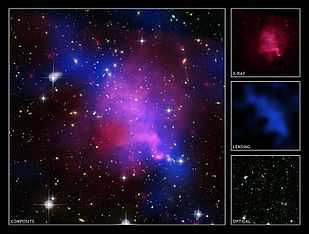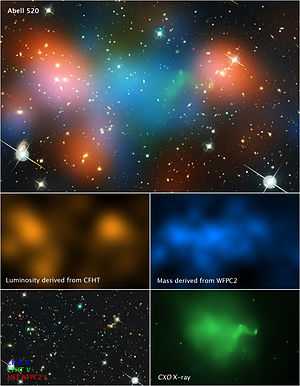Abell 520
| Abell 520 | |
|---|---|
|
Abell 520. Imaged January 2012. Credit: NASA | |
| Observation data (Epoch J2000) | |
| Constellation(s) | Orion |
| Right ascension | 04h 54m 03.80s[1] |
| Declination | +02° 53′ 33.00″[1] |
| Number of galaxies | 289+[2] |
| Richness class | 3[3] |
| Bautz-Morgan classification | III[3] |
| Velocity dispersion | 1,066 km/s[2] |
| Redshift | 0.2[4][5] |
| Distance (co-moving) |
811 Mpc (2,645 Mly) h−1 0.705 [1] |
| ICM temperature | 9.8 keV[5] |
| Binding mass |
17×1014 h−1 0.70[2] M☉ |
| X-ray luminosity | 14.44×1044 erg/s (0.1–2.4 keV)[5] |
| X-ray flux | 8.4×10−12 erg s−1 cm−2 (0.1–2.4 keV)[5] |
| Other designations | |
| The Train Wreck Cluster | |
| See also: Galaxy groups, Galaxy clusters, List of galaxy clusters | |

The Abell 520 galaxy cluster is an unusual structure resulting from a major merger. It has been popularly nicknamed The Train Wreck Cluster,[6][7][8] due to its chaotic structure, and is classified as a Bautz-Morgan type III cluster.[3] It is at a co-moving radial distance of 811 Mpc (2,645 Mly) and subtends 25 arcminutes on the sky.[1]
At one time, this cluster appeared to present a challenge prevailing theories about dark matter as well as most alternative theories of modified gravity, because its dark matter content appeared to be distributed in a way which was very different to the usual pattern, and which did not have a simple explanation based on dark matter that only interacts gravitationally.[9] As a result, at one time it was believed that the distribution of the dark matter was the result of a novel mechanism associated with large scale filaments rather than galaxies. An analysis[2] of the motions of 293 galaxies in the cluster field suggested that Abell 520 was a cluster forming at the crossing of three filaments of the large scale structure.
However, more precise observations since this time have shown that the earlier observations were misleading, and that the distribution of dark matter and its ratio to normal matter are very similar to those in galaxies in general, making novel explanations unnecessary. [10]
See also
- Abell catalogue
- Bullet Cluster
- List of Abell clusters
- List of galaxy clusters
References
- ↑ 1.0 1.1 1.2 1.3 "NED results for object ABELL 0520 - BASIC DATA for ABELL 0520". NASA/IPAC EXTRAGALACTIC DATABASE. Retrieved March 3, 2012.
- ↑ 2.0 2.1 2.2 2.3 Girardi, M.; Barrena, R.; Boschin, W.; Ellingson, E. (Nov 2008). "Cluster Abell 520: a perspective based on member galaxies. A cluster forming at the crossing of three filaments?". Astronomy and Astrophysics 491 (2): 379–395. arXiv:0809.3139. Bibcode:2008A&A...491..379G. doi:10.1051/0004-6361:200810549.
- ↑ 3.0 3.1 3.2 Table 3, page 24 in Abell, George O.; Corwin, Harold G., Jr.; Olowin, Ronald P. (May 1989). "A catalog of rich clusters of galaxies" (PDF). Astrophysical Journal Supplement Series 70 (May 1989): 1–138. Bibcode:1989ApJS...70....1A. doi:10.1086/191333. ISSN 0067-0049. Retrieved March 12, 2012.
- ↑ Struble, Mitchell F.; Rood, Herbert J. (November 1999). "A Compilation of Redshifts and Velocity Dispersions for ACO Clusters". The Astrophysical Journal Supplement Series (The University of Chicago Press) 125 (1): 35–71. Bibcode:1999ApJS..125...35S. doi:10.1086/313274. Retrieved March 3, 2012.
- ↑ 5.0 5.1 5.2 5.3 Ebeling, H.; Edge, A. C.; and 6 others. (December 1998). "The ROSAT Brightest Cluster Sample - I. The compilation of the sample and the cluster log N-log S distribution". Monthly Notices of the Royal Astronomical Society (MNRAS) 301 (4): 881–914. arXiv:astro-ph/9812394. Bibcode:1998MNRAS.301..881E. doi:10.1046/j.1365-8711.1998.01949.x. Retrieved March 3, 2012.
- ↑ "‘Cosmic train wreck’ stumps dark-matter physicists". physicsworld.com.
- ↑ "Cosmic 'train wreck' defies dark matter theories - space -". New Scientist. Retrieved 16 August 2007.
- ↑ "Abell 520: Dark Matter Mystery Deepens in Cosmic "Train Wreck"". Retrieved 16 August 2007.
- ↑ Mahdavi, A.; H. Hoekstra; A. Babul; D. Balam; P. Capak (2007). "A Dark Core in Abell 520". Astrophysical Journal 668 (2): 806. arXiv:0706.3048. Bibcode:2007ApJ...668..806M. doi:10.1086/521383.
- ↑ Douglas Clowe1, Maxim Markevitch, Maruša Bradač, Anthony H. Gonzalez, Sun Mi Chung, Richard Massey, and Dennis Zaritsky. "ON DARK PEAKS AND MISSING MASS: A WEAK-LENSING MASS RECONSTRUCTION OF THE MERGING CLUSTER SYSTEM A520". The Astrophysical Journal. doi:10.1088/0004-637x/758/2/128.
External links
- Universe Today, Galaxy Cluster Collision Creates a Dark Matter Core
- Dark Matter Core Defies Explanation
Coordinates: ![]() 04h 54m 03.80s, +02° 53′ 33.00″
04h 54m 03.80s, +02° 53′ 33.00″
| ||||||
| ||||||||||||||||||||||||||||||||||
